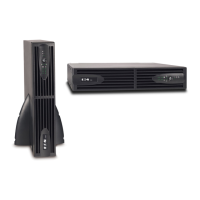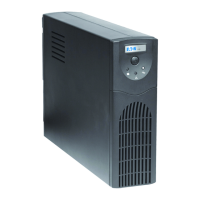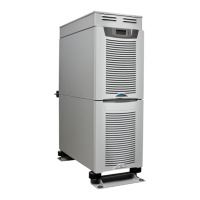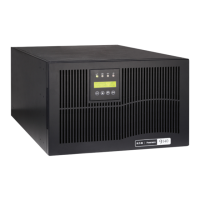UPS System Installation
Eaton
®
Power Xpert
®
9395P-900 UPS Installation and Operation Manual P-164000501—Rev 09 www.eaton.com/powerquality 4-29
Table 4-1. TB1, TB2, and TB3 Interface Connections
Terminal TB1 Name Description
1 REPO NC
Input: Normally-closed dry contact used to activate UPS EPO from a remote switch.
2 REPO Return
3 REPO NO
Input: Normally-open dry contact used to activate UPS EPO from a remote switch.
4 REPO Return
5 Battery Aux
Input: Normally-open contact used to indicate when UPS battery breaker is open or closed
6 Battery Aux Common
7 48 Vdc Battery Shunt Trip +
Output: Contacts used to open battery breaker or disconnect.
8 48 Vdc Battery Shunt Trip
–
9 Output Contactor K3 NC Aux
Output: Normally-closed contact opens when output contactor closes.
10
Output Contactor K3 NC Aux
Common
Terminal TB2 Name Description
1 Pull Chain
Output: Backup control for parallel operation.
2 Pull Chain Common
3 Alarm Relay NC
Output: General purpose normally-closed (NC) relay contact.
4 Alarm Relay Common
5 Alarm Relay NO
Output: General purpose normally-open (NO) relay contact.
6 Alarm Relay Common
7 Not Used
8 Not Used
9 Not Used
10 Not Used
Terminal TB3 Name Description
1 Building Alarm 1
Input: Programmable UPS alarm, activated by a remote dry contact closure.
2 Building Alarm 1 Return
3 Building Alarm 2
Input: Programmable UPS alarm, activated by a remote dry contact closure.
4 Building Alarm 2 Return
5
Building Alarm 3 Default:
Charger Off
Input: Programmable UPS alarm, activated by a remote dry contact closure. Default
function set for charger off.
6 Building Alarm 3 Return
7
Building Alarm 4 Default: On
Generator
Input: Programmable UPS alarm, activated by a remote dry contact closure. Default
function set for on generator.
8 Building Alarm 4 Return
9
Building Alarm 5 Default:
Maintenance Bypass
Input: Programmable UPS alarm, activated by a remote dry contact closure. Default
function set for maintenance bypass.
10 Building Alarm 5 Return
NOTE “Return“ indicates connection to electronics circuit ground. “Common” indicates connection to common side of isolated relay contact.

